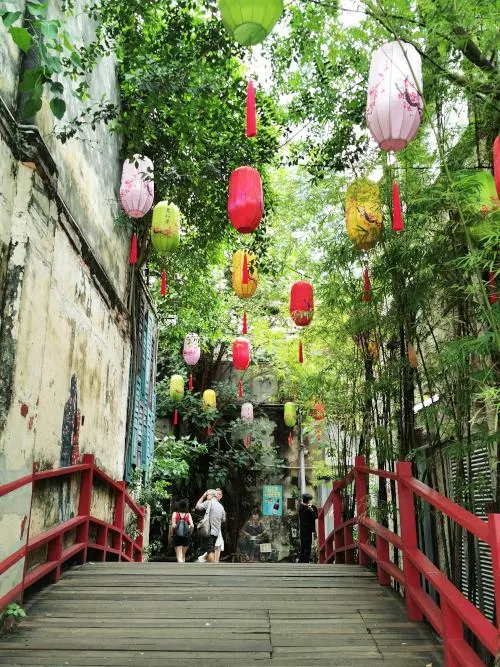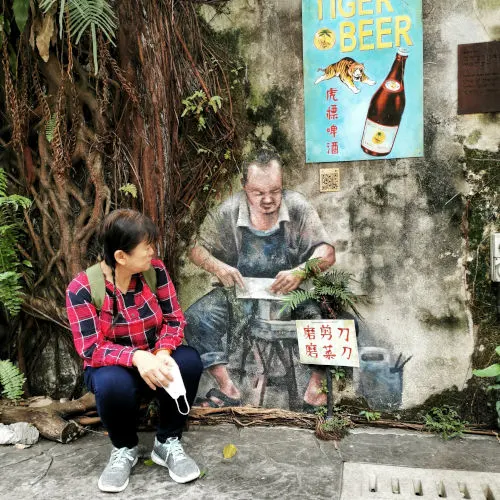Kwai Chai Hong 鬼仔巷 is the latest tourist attraction in the Chinatown of Kuala Lumpur. It is a small alley behind Petaling Street with numerous murals depicting the daily life at this place in the old days.
This lane has been there for almost a century old. It was in a dilapidated state for many years and has been lovingly refurbished recently.

Where is Kwai Chai Hong?
Kwai Chai Hong is the Cantonese transliteration of the three characters 鬼仔巷. It means 'Little Ghost Lane' or 'Little Demon Alley'.
There are two possibilities for the origin of the name. One theory is that the Chinese refer to naughty children as Kwai Chai 鬼仔. Since this is where the place where the kids like to play, and hence the name was given.
The other possibility is that this is where the gangster, drunkards, and drug addicts engaging vice activities, and hence, it was given a name with a negative connotation.
Lastly, it was the hideout of the underground gang Dragon Tiger Clan the members are called Kwai Chai 鬼仔
The entrance of Kwai Chai Hong
The pre-war building at Kwai Chai Hong is the best-kept secret of the Chinatown area in Kuala Lumpur. You can easily miss it because it is a hidden alley. It is the back lane of Jalan Panggung.

Chinatown is virtually synonymous with Petaling Street or Jalan Petaling, which stretches beyond the mega arches of Chinatown.
Project Kwai Chai Hong involves ten restored shophouses — six fronting Jalan Petaling and another four units along Lorong Panggung, as well as a delightful laneway tucked between the two roads of Jalan Petaling and Lorong Panggung.


How does Kwai Chai Hong start?
Kwai Chai Hong was started as a project by Zeen Chang, the managing director of a local space management company, Bai Chuan Management Sdn Bhd.
The initial thought was to bring back the memory of the era of the 60s, the golden era of the KL Chinatown to the present. Her initial thought was just want to rent this place to make some money, but subsequently, she fell in love with this place and invest more to speed up the restoration work.
Many impressive murals drawn by the local artist start to attract tourists, and eventually, it turns into one of the most Instagram-able spots in the KL Chinatown.
The Murals
There are six murals in this alley that portray the daily life of the bygone era in the 1960s. They are all drawn by the local artists.
The red bridge
Once you enter the area, you will be greeted by the colorful red bridge called 红桥. Over here, you will find the first mural on your right, a loving couple sitting on the bridge.

Scan the QR code
There is a QR code on every mural. A soundtrack will play by scanning the code on the wall to provide an interactive experience of the mural paintings through sight and sound.


Erhu uncle
There are more murals once you cross the bridge.
Erhu is a traditional Chinese string instrument with only two strings. The mural illustrates the Chinese migrants entertaining themselves with their traditional musical instruments in their past time.

Kids playing with imaginary friends
There was not much entertainment for kids in that era. But our Gen Z friend is so intrigued by the mural that he wants to play with them.

Prostitute
Age-old brothel businesses flourished across the geological eras.
Our new generation does not bother it too much. Kwai Chai Hong is now a favorite spot for portraits for models.

A calligrapher
Many illiterate migrants are living in this area in those days. This mural shows a Chinese calligrapher helping the residents to write letters home and also couplet with auspicious sayings during the spring festival.


The century-old lamp post
There is a lamp post about fifteen steps after crossing the red bridge.
This lamb post is believed to be the only surviving one from the first set of lampposts installed in Kuala Lumpur. It was installed around 1903 when electricity was first available to the city.

Life in the sixties
At the end of the alley is a staircase that leads visitors to a remarkable two-and-a-half-story mural. This mural is the highlight of Kwai Chai Hong. It depicts the 1960s era where the business is bustling, and residents are living where they work.
There is a barber carrying out their business in the open air (in the mural), and you can sit on the (real) barber chair right in front for a haircut 🙂



The four-season art
Kwai Chai Hong has received a makeover last year, with new artworks and more murals, and many unique cafes mushrooming in the vicinity.
This is the latest addition to the mural art at the entrance of Kwai Chai Hong, created by the Malaccan-born artist @andha.ras took one month to finish.

Ho Kow Hainam Kopitiam
The trip to Kwai Chai Hong is not complete if you do not drop by the Ho How Hainan Kopitiam near the entrance of the lane.
Why is it so special? It is self-explanatory in this image, I queue up in the morning before the shop opened for business. This image was taken when I left. The crowd waiting for a seat on a Sunday morning is so large that it takes an average of an hour to be seated.

An interesting menu of Ho Kow Hainan Kopitiam (Kopitiam means Coffee shop). This image is the cover, which looks like a newspaper.

Kwai Chai Hong: Useful Information
Address: Jalan Panggung, Kuala Lumpur City Centre, 50000 Kuala Lumpur, Federal Territory of Kuala Lumpur
Geographic coordinates: 3.141525, 101.697596
Opening hours: Daily, 9 am to 6 pm
Go by bus: Take bus 821 to Pasar Seni, 3 stop from KL Sentral.
Go by MRT: KJ15 is the station nearest to Kwai Chai Hong, 3 stops from KL Sentral.
Distance from city center: At the city center, next to Petaling Street
Best time to visit: Arrive before 10 AM to avoid crowds.
Dress code: No specific dress code
Entrance fee: Free

Angela
Monday 16th of January 2023
A great post showing the wonderful street art in this area. I will definitely be visiting on my next trip. What would you suggest I order when going to Ho Kow Hainan Kopitiam if I am there when it opens?
kwankp
Tuesday 17th of January 2023
Try the local coffee, half-boiled egg, and toast with butter/kaya. This is a typical Malaysian breakfast.